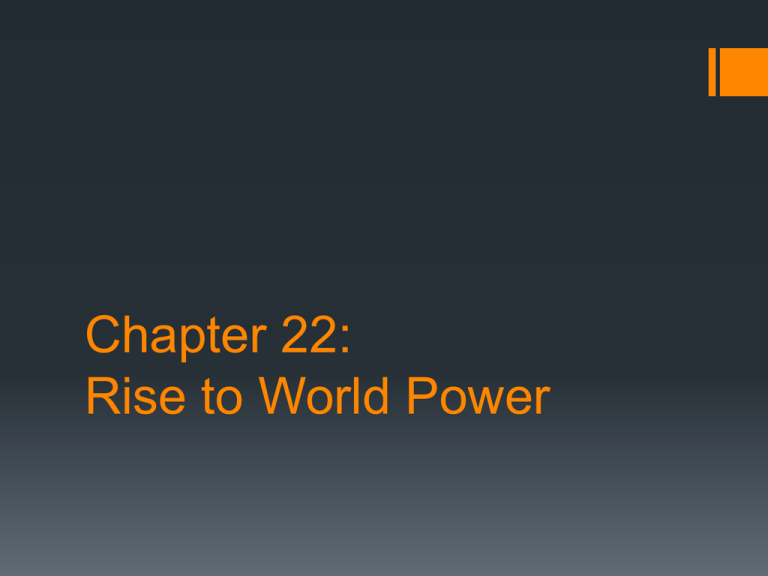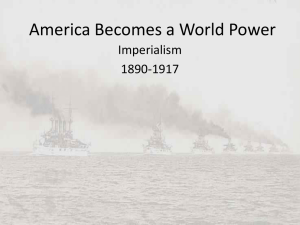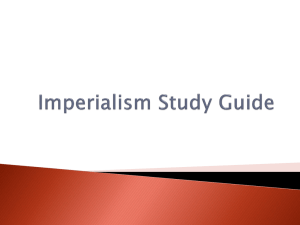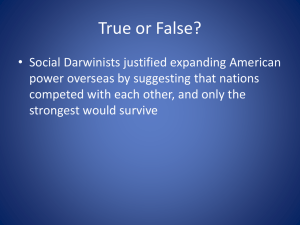Chapter 22: Rise to World Power
advertisement

Chapter 22: Rise to World Power Section 1: Expanding Horizons Essential Question: Why did the United States extend its influence to other regions in the late 1800s? American Foreign Policy Main idea: The influence of the US began to extend to other world regions. George Washington said, “steer clear of permanent alliances with any portion of the foreign world” Some people thought this meant US should be isolated Others thought it meant to expand our empire America practiced expansionism: expanding a nation’s borders Already trade partners with China, US sought to expand trade with Japan Matthew Perry: traveled to Japan to negotiate trade Treaty of Kanagawa was signed in 1854 allowing trade between US and Japan An Age of Imperialism Main idea: The US expanded its territory when it bought Alaska and extended its influence into Latin America. Imperialism: Large empires trying to gain control over weaker nations Other nations, not just US, were practicing this policy After the Civil War, many Americans wanted to build an empire Annexing new lands This would give them the rightful place at the center of power William H. Seward, Secretary of State agreed with this Appointed by Abraham Lincoln Wanted to dominate the Caribbean, Central America, and the Pacific This would help provide more rapid communication by linking the Atlantic and Pacific oceans. An Age of Imperialism (cont.) Purchase of Alaska 1867 Seward’s vision began to come to life US bought Alaska from Russia for $7.2 million Great bargain, as it is 2x the size of TX Nicknamed “Seward’s Ice Box”, “Polar Bear Garden” by those who disagreed with the decision Most notably known as “Seward’s folly”, but after awhile people realized it was a wise decision US had a good trade relationship with Latin America Pan-American Union: promoted cooperation among member nations Made relationship between United States and Latin America even close During this time, the United States also worked to build up our navy Captain Alfred Thayer: President of the Naval War College During the 1800s, US went from sails to steamships Section 2: Imperialism in the Pacific Essential Question: Why did the United States expand its role in the Pacific? Hawaii Main idea: The United States strengthened its foothold in the Pacific by annexing Hawaii and part of Samoa Americans wanted a trade stop in the Pacific Had already acquired Midway Islands Hawaii consists of 8 large and about 100 smaller islands In 1790s Americans and Hawaiians began to trade King Kamehameha I began to unify the islands shortly after Island population was devastated by diseases brought via trade Hawaii (cont.) In 1820, US missionaries established schools, created written Hawaiian alphabet, and translated the Bible into Hawaiian Sugarcane became a big deal in Hawaii in the 1830s An American firm introduced sugarcane to Hawaiians No tariffs on sugar American influence in Hawaii stayed strong, even after they gained independence in 1842 Tariff on Hawaiian sugar in 1890s As a result, sugar exports to US dropped drastically Hawaii (cont.) Queen Liliuokalani came to the throne in 1891 Took away powers of American sugar planters Was overthrown by Americans who set up their own provisional government (temporary government) “Now, to avoid any collision of armed forces, and perhaps the loss of life, I… yield my authority.” Planters’ Revolt was a success This resulted in the annexation, or addition, of Hawaii to the United States 2 Presidents denied the annexation, but McKinley passed in in 1900 Samoan Islands US Navy base at Pago Pago Without consulting them, US and Germany split Samoa Us kept their portion, Germany returned theirs for rights to other Pacific Islands China and the Open Door Main idea: The Open Door Policy protected and expanded US trading interests in China. Many of the Pacific Islands that were annexed or purchased were seen as stepping stones to China China had several spheres of influence, or areas of special rights within it Japan, Germany, Great Britain, France and Russia all had influence To protect and expand US trading rights, John Hay proposed the Open Door Policy Gave each foreign nation in China rights to trade freely in the other spheres of influence China (continued) In 1899, the Boxers (a Secret Society) revolted against what they called “foreign devils” Foreign troops won Second Open Door Policy put into place Stressed the importance of maintaining China’s independence Japan Main idea: The relations between Japan and the US were strained in the early 1900s. Japan ignored the Open Door Policy, which led to war with Russia and conflict with the United States Clash over Manchuria (lots of natural resources) Lead to Russo-Japanese War Lasted until 1905 (less than a year) Both countries resources were exhausted To create peace, Treaty of Portsmouth was signed Treaty of Portsmouth was signed in September 1905 Teddy Roosevelt met with Russian and Japanese leaders to settle their differences Japan got control of Korea in return for Japan’s pledge to half expansion Japan (continued) During the war, many people from Japan immigrated to the United States Most settled in California Separate schools were introduced, and later protested In order to integrate the schools, Roosevelt had Japan restrict emigration This did not totally fix things and actually strained the relationship more Many Americans called for WAR! Rather than go to war, Roosevelt sent 16 white battleships on a cruise around the world “The Great White Fleet” Impressed the Japanese By 1909 conflict was mostly resolved Section 3: Spanish-American War Essential Question: How did the SpanishAmerican War help the United States become a world power? “A Splendid Little War” Main Idea: Events in Cuba led to war between the United States and Spain in 1898. Charge of the Rough Riders takes place in Cuba About 90 miles from US shores Cubans had lived under Spanish rule for centuries Several unsuccessful rebellions The struggle of the Cubans worried the United States Mainly worried about a rebellion so close to us Many Americans wanted the government to do something about the cruelty to Cuba President Grover Cleveland wanted to stay out of it This was highly controversial and newspaper articles only fueled the fire Joseph Pullitzer and William Randolph Hearst among the many writers Created a frenzy that they thought would lead to war This is called YELLOW JOURNALISM Remember the Maine President McKinley was trying to resolve matters peacefully, but problems were growing by the hour Riots in Havana, Cuba cause him to respond McKinley sends the battleship Maine to Havana to protect American citizens and property The ship remained quietly at anchor in the harbor for 3 weeks On Feb. 5, 1898, a huge explosion shattered the Maine Killed 260 officers and crew members Newspapers in America instantly blamed Spain, Spain denied it Americans wanted war with Spain “Remember the Maine” McKinley sent Spain a strong note and demanded a truce to end the loss of lives and destruction of property Spanish partially agreed, but not to McKinley’s liking, so we declared war on Spain War in the Philippines While the events in Cuba sparked the war with Spain, the first military actions occurred in the Spanish colony of the Philippines Spanish navy base was here Commodore George Dewey launched a surprise attack May 1 Manila Bay Destroyed most of the Spanish ships American troops arrived in July and Filipino rebels helps the Americans capture Manila Bay Rebels used American weapons to continue their war path and overtook the main island of Luzon and declared independence Fighting in Cuba While the war in the Philippines was brewing, there was also tension in Cuba Spanish fleet entered harbor at Santiago on May 19 American ships soon blockaded the coast, trapping the Spanish ships About 17,000 American troops were sent in Heavy fighting followed Rough Riders, a group led by Teddy Roosevelt, was sent in to aid American efforts On July 1, they joined the Battle of San Juan Hill Had African American soldiers fighting alongside white soldiers Americans captured San Juan Hill Ended Spanish resistance in Cuba Later, US went after Puerto Rico and the Spanish signed it over quite easily and ended the war Losses in the War Nicknamed “a splendid little war” by Secretary of State John Hay Total war lasted fewer than 4 months About 400 Americans died from battle More than 2,000 Americans died from disease such as malaria, yellow fever and other tropical climate diseases African Americans serving in the war faced harsh discrimination They were put in segregated units Acquisitions Treaty of Paris was signed by United States and Spain to end the Spanish-American war Dissolved (removed) most of Spanish Empire Cuba became an American protectorate (controlled by US, but still independent) Platt Amendment prohibited Cuba from making treaties with other nations Puerto Rico and Guam also became US territories Under the Foraker Act, US set up a new American government in Puerto Rico American citizenship granted to all Puerto Ricans in 1917 (Jones Act) Acquisitions (continued) US gets the Philippines for $20 million Caused some debate among Americans Some thought controlling this territory went against the democratic principles of the US Others were all for it! Rebellion in the Philippines US quickly learned that controlling this area would not be easy Emilio Aguinaldo’s forces began a fight for independence in 1899 More than 4,000 Americans died as a result Filipinos suffered more with at least 200,000 deaths Aguinaldo was captured in March 1901 and his soldiers surrendered In the summer of 1901, William Howard Taft took over the government and helped prepare them for eventual self-rule Philippines gained independence in 1946 Section Review: 1. How did newspapers contribute to America’s declaration of war against Spain in 1898? 2. Why did some Americans oppose empire building by the United States? 3. Use a time line to summarize the events in the Philippines after the end of Spanish rule in 1898. 4. Write an account of the Battle of San Juan Hill from the point of view of an African American soldier in the ninth cavalry. 5. How did the Spanish-American War help the United States become a world power? Section 4: Latin American Policies Essential Question: How did the beliefs of US Presidents shape Latin American foreign policies? Panama Main idea: The United States negotiated with Panama to build the Panama Canal. Americans and Europeans had wanted to build a canal across Central America, connecting the Atlantic and Pacific, for hundreds of years They wanted to eliminate the long sea voyage around South America With United States’ new land ownership in both areas, it was more crucial than ever Panama was an isthmus (narrow strip of land connecting two larger bodies of land) Located between Caribbean Sea and Pacific Ocean, it made the perfect place for the canal 1879- French failed at building a canal near here US had two sites they were debating to use and finally chose Panama French offered to lease us the land, making it an easy choice ($40 mil) We also had to negotiate with Colombia, we came up with $10 million down and $250,000/year for rent Revolution in Panama Colombian Senate rejected US offer (previous slide) The only way to get the land would be for Panama to be an independent nation and allow the US to build there US aided in a revolt against the Colombians Warship Nashville Colombia loses, US gets what they want The Panama Canal On November 6, 1903, the US recognized Panama’s independence Less than 2 weeks later, Hay signed a treaty that gave the US a 10 mile strip of land across the country Now, we could build our canal Some people were not happy about this, but most were excited to start work on the canal The Grand Opening August 15, 1914 Cargo ship named the Ancon made the first voyage through the new waterway Trip could now be completed in half the time This proved to be a very valuable investment for the United States Ability to move goods, as well as navy ships Many Latin American Nations did not like the way we acquired the land Policing the Western Hemisphere Main idea: Using its economic and military power, the US policed the Western Hemisphere. “Speak softly and carry a big stick.” – President Roosevelt He felt it was necessary for the United States to serve as the protectors of the western world In order to keep things from falling into anarchy Roosevelt Corollary America’s right to act as a “policeman” in Latin America and to intervene when needed Dollar Diplomacy After Roosevelt,








